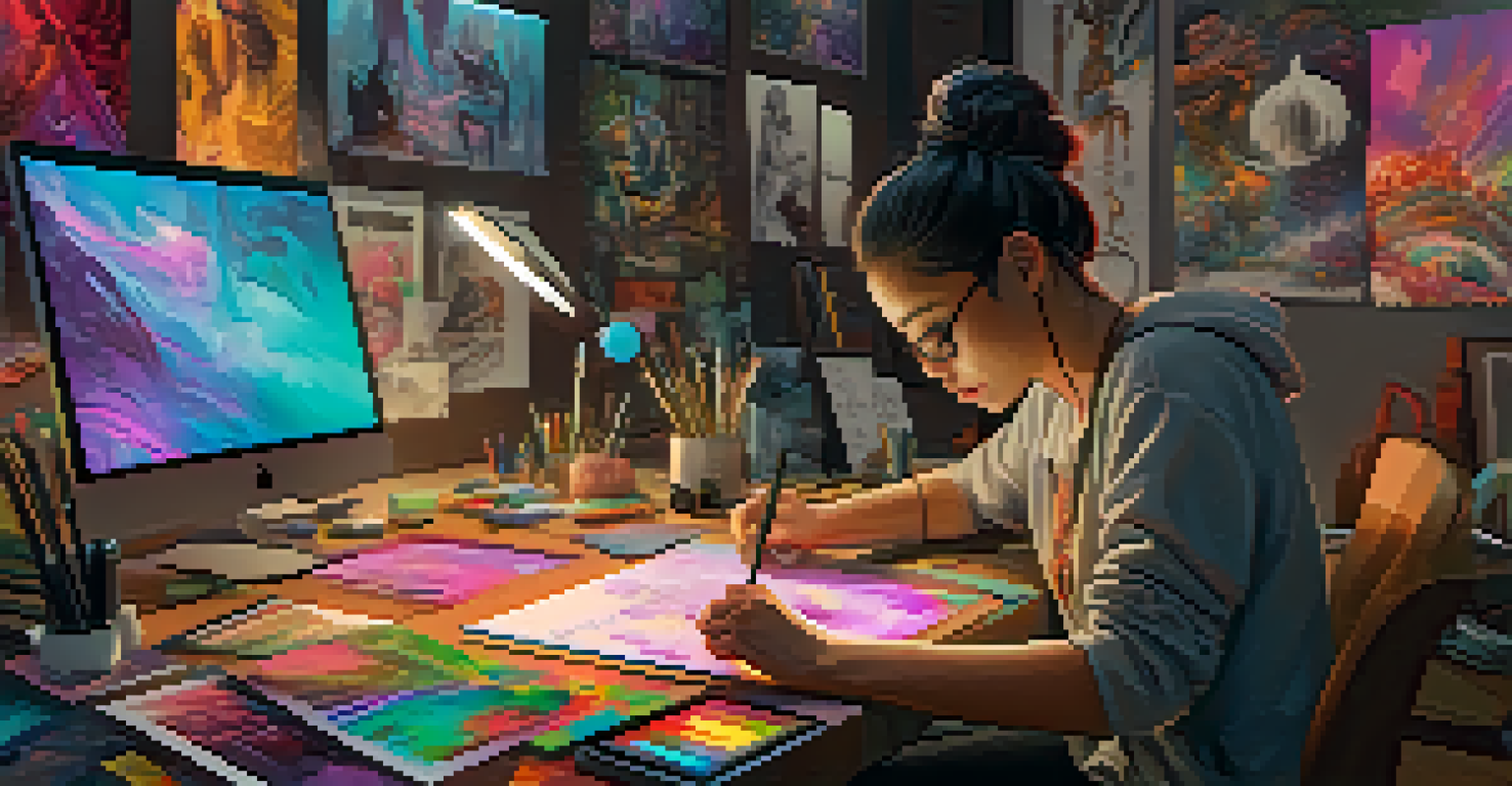How NFTs Challenge Traditional Intellectual Property Laws

Understanding NFTs and Their Rise in Popularity
Non-fungible tokens, or NFTs, are unique digital assets verified using blockchain technology. Unlike cryptocurrencies, which are interchangeable, NFTs represent ownership of a specific item, such as digital art or music. Their rise in popularity can be attributed to the growing interest in digital ownership and the potential for creators to monetize their work directly.
Intellectual property is the oil of the 21st century.
For example, artists can sell their work as NFTs, allowing them to retain some control over how their art is used and shared. This model contrasts sharply with traditional art sales, where once a piece is sold, the artist often loses rights to future profits. The appeal of NFTs lies in their ability to create a direct relationship between creators and consumers.
As more artists and creators embrace NFTs, the question arises: how do these unique assets fit into the existing framework of intellectual property laws? This intersection of technology and law is where the challenges begin.
Traditional Intellectual Property Laws Explained
Intellectual property (IP) laws are designed to protect the rights of creators and inventors over their original works. These laws include copyright, trademarks, and patents, each serving a specific purpose in safeguarding creative expressions. Copyright, for instance, protects the expression of ideas, while trademarks protect brand names and logos.

Traditionally, IP laws have provided a framework to ensure that creators can benefit financially from their work. However, the rapid evolution of technology, especially with the advent of the internet, has posed challenges to these laws. Many creators have struggled to navigate the complexities of IP rights in a digital landscape where copying and sharing are just a click away.
NFTs Redefine Digital Ownership
NFTs enable creators to maintain control over their work and establish direct relationships with consumers, challenging traditional sales models.
As NFTs become more prevalent, the need for a reevaluation of these laws grows. Are existing IP laws sufficient to address the nuances of digital ownership and distribution that NFTs introduce?
How NFTs Challenge Copyright Laws
Copyright laws are designed to protect the creator's exclusive rights to their work. However, with NFTs, the ownership of a digital asset can be transferred without transferring copyright itself. This means someone might own an NFT of a piece of art but not have the right to reproduce, distribute, or display it publicly.
The future of creativity is in the hands of those who understand the power of digital ownership.
This unique situation creates confusion for both artists and collectors. For instance, if a buyer purchases an NFT of a digital painting, do they have the right to print it on merchandise? The lack of clarity around these rights can lead to disputes and misunderstandings.
As NFTs continue to gain traction, it becomes increasingly clear that copyright laws need to adapt. Policymakers and legal experts are tasked with redefining what ownership means in the digital age.
The Implications for Trademark Rights
Trademark laws protect brands and their identities, preventing confusion among consumers regarding the source of goods and services. With NFTs, there's potential for trademark infringement, especially when digital art or products resemble established brands. For example, if an NFT artist creates a piece that closely mimics a well-known logo, it could lead to legal challenges.
Moreover, as brands begin to enter the NFT space, they must navigate the complexities of trademark rights in this new environment. Companies may wish to create their own NFTs to engage with consumers, but they must ensure their designs don't infringe on existing trademarks.
Copyright Laws Need Reform
The ownership model of NFTs raises questions about copyright transfer, highlighting the need for updated legal frameworks to clarify rights.
The intersection of NFTs and trademark issues highlights the need for businesses to be diligent in protecting their brands. As the NFT market evolves, so too will the regulatory landscape surrounding trademarks.
Licensing Issues in the NFT Space
Licensing refers to the permission granted by a copyright holder to use their work under specific conditions. In the NFT world, licensing can become complicated, as buyers might not fully understand what rights they acquire with their purchase. Some NFTs come with clear terms, while others do not, leading to potential legal grey areas.
For instance, if an NFT creator sells a digital artwork without clearly stating the licensing terms, the buyer may assume they have more rights than they actually do. This lack of clarity can lead to disputes, especially if the buyer attempts to reproduce or sell the artwork.
As the NFT marketplace grows, establishing standardized licensing agreements could help mitigate these issues. Clear communication between creators and buyers is essential to ensure everyone is on the same page.
Global Variations in Intellectual Property Laws
Intellectual property laws vary significantly from country to country, which complicates the NFT landscape on a global scale. While some nations have robust protections for IP rights, others may not recognize certain rights at all. This inconsistency can pose challenges for creators looking to sell their NFTs internationally.
For example, an artist in the U.S. might have strong copyright protections, but a buyer in a country with weaker laws may not have the same rights. This disparity can create confusion and potential exploitation of creators in less protective jurisdictions.
Global IP Laws Create Confusion
Variations in intellectual property laws across countries complicate the NFT market, necessitating a harmonized approach to protect creators internationally.
As the NFT market expands across borders, the need for a harmonized approach to IP laws becomes increasingly important. International cooperation could help protect creators and ensure fair practices globally.
Future Directions for Intellectual Property Laws
As NFTs continue to challenge traditional intellectual property laws, there is a growing call for reform. Policymakers, legal experts, and industry stakeholders need to come together to develop a legal framework that addresses the unique aspects of digital ownership. This may include new definitions of ownership, rights, and responsibilities associated with NFTs.
Potential solutions might involve creating specific regulations tailored to the NFT market, ensuring that creators are protected while also allowing for innovation and creativity. Additionally, educating artists and buyers about their rights and responsibilities can help minimize conflicts.

Ultimately, the future of intellectual property laws in relation to NFTs will depend on collaboration and adaptability. As the technology evolves, so too must the legal structures that govern it.